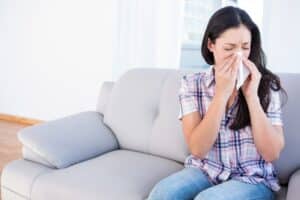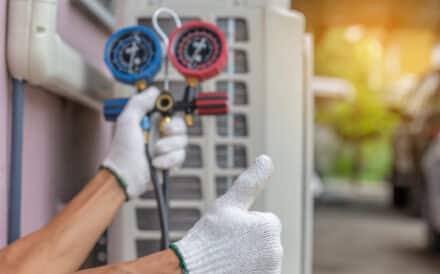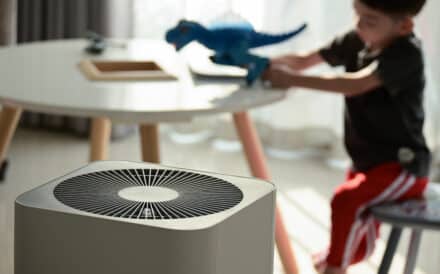How Does Air Quality Affect Allergies? What Can You Do?

Why do allergies follow you indoors? This is something everyone finds themselves wondering about eventually. Allergies, for the most part, come from plants and sometimes animals outdoors. Pine pollen, ragweed, and cedar all cause widespread seasonal allergies, but those allergies should fade when the seasons change. Likewise, if you have a pet allergy to dogs or cats, shouldn’t that allergy fade when the animal leaves the room?
If you’re still sneezing after your allergens are gone, this is a matter of air quality. Believe it or not, air quality inside your home or office can play a major role in your allergies.
Here at Silver State, we believe in a whole-home approach to maintenance and health. So let’s explore the interesting relationship between air quality and allergies.
Your Air Filter and Allergens
First, let’s look at how allergens move through a home and office building. Allergens can be generated indoors or outdoors. Outdoor allergens include pollen, spores, and insects. Indoor allergens include dust, pet dander, and mold. These allergens are released as tiny particles in the air that can, for example, fly into a nose and cause an allergic sneezing fit.
HVAC Cycles and Filters the Air
From there, your HVAC system uses fans to draw the air in from the intake vent. The air then passes through a filter, then through the unit and finally back out through the ducts. This means that every time air cycles through the building, it should be filtering out just a few more allergen particles every time. The higher MERV rating your filter is, the more allergens will be captured in the filter with every pass.
Indoor air intakes mean that air continues to cycle and filter again and again, potentially getting cleaner over time. It doesn’t matter if allergens come from indoors or outdoors, everything gets filtered.
Over time, the indoors will have significantly fewer allergens than the outdoors, making it easier to breathe and enjoy life for those experiencing allergies.
Poor Air Quality Leads to Increased Allergens
So what happens if your air quality is poor? This can happen if your HVAC is not cycling air efficiently or if the filters are clogged. An old filter is the number one reason for poor air quality in a building. Even if your HVAC is functioning perfectly, a clogged filter can slow the airflow and refuse to trap more dust and allergens. In fact old trapped particles can be knocked loose once the air filter has become too old and packed with grime.
When this happens, new allergens are still entering the building at a seasonal pace. But a poorly performing HVAC won’t be able to intake all the new allergens, and a clogged filter won’t be able to stop them. Over time, you will notice a decrease in your air quality, resulting in both increased dust and increased allergies.
In fact, poor air quality can often be defined by the concentration of allergens left unfiltered, still floating in the air to tickle every nose and settle on every surface.
The Hidden Source of Out-of-Season Allergy Attacks
When you think of your air as floating with dust and your air filter as removing that dust, it’s easy to see how poor air quality could lead to increased allergies. But what about allergies that come back indoors long after pine, pollen, or ragweed season is over? This is a unique quality of homes and offices with poorly functioning air circulation or filtration.
Old allergens can take root in the filter or lodge in corners and upholstery inside the building. Later on, if a couch, vent, or pocket of pollen in the clogged filter are disturbed, unseasonal allergy spores are suddenly released back into the circulating air system. The air quality drops, and your likelihood of a sudden unseasonal allergy attack increases.
The better your air quality, the less seasonal allergens can linger indoors to settle on curtains and vent covers. These particles are filtered more consistently over time, and pockets of pollen don’t hide in a constantly refreshed filter.
Reduce Allergens by Improving Air Quality
A well-ventilated and filtered building can become an oasis of allergies by filtering and re-filtering the air through functional, high MERV filters. Homes and offices become places safe for those with both seasonal and environmental allergies. The more consistently you maintain your air quality, the fewer allergens will last in your indoor spaces.
Make sure your air filter is replaced on-time and consider upgrading your MERV rating – filtration density – to catch more dust and pollen with each pass. Keep your HVAC units in good repair to ensure the air cycle is both efficient and the channel is clean. Clean to every corner to eliminate places where old dust and out-of-season allergens might be lurking. Pay special attention to curtains, room corners, and soft furniture.
Finally, dust and clean all your vent covers and consider having your ducts cleaned of any lingering old dust and allergens waiting to be re-released.
Air quality has a profound effect on allergies when indoors because air quality can be measured in allergens. The more dust and pollen you remove with each cycle and the more efficient your air cycling, the better your air quality will be. The fewer of those particles are in the air, the fewer allergic symptoms you will experience in doors.
Silver State offers a large variety of services, ranging from home plumbing to commercial refrigeration and everything in between. No matter which service you need, you’ll be working with technicians who are extensively trained and highly knowledgeable. Find us for your residential and commercial needs in Nevada, California, and Arizona.
For more air quality insights or expert home and commercial HVAC services, contact us today.




